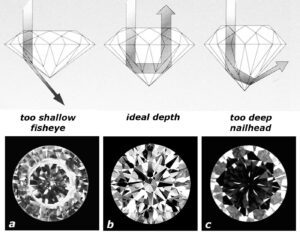Diamond Design and Light Performance Analysis 101 .
A brilliant cut diamond’s appearance is a kaleidoscopic pattern of many internal reflections (called “virtual facets”) of surrounding light sources, which are mirrored to the viewer after reflecting from the diamond’s pavilion facets.
The numerous reflections from virtual facets are the fundamental elements of diamond beauty and light performance. Each is a potential point of light, sparkle or fire, as seen in wire frame outline in Figure 2b and in the Ideal Cut diamond photo, Figure 2c. 
Figure 3.

Most everyone learning about diamonds and their cutting has seen ray tracing like that shown in Figure 3. For more than 80 years these ray trace diagrams have been used to graphically explain to the consumer the superior light performance of the Ideal round brilliant cut and the two examples of poor diamond cutting, the fish-eye and nail head.
It will surprise many to learn that the historical raytrace diagrams in Figure 3 are inadequate, and fail to explain the light performance in all three of these diamond cut examples.
(Although incorrect for diamonds, these conventional diagrams do explain some aspects of light performance in gemstones with refractive indexes much lower than diamond).
Demonstrated in the work that follows is a unique way to use 3-dimensional raytracing to test these conventional explanations.
View full article and download the pdf version.